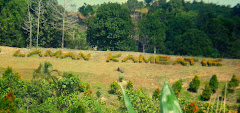
Roses Are Red, Violets Are Blue,
Laman Kambatik ,Thine name I give you!
 Heliconia latisphatha
Heliconia latisphatha - this is a recommended kambatik spp. because of its exoticness. There around 100 evergreen perennial species and hybrids in this genus. Excellent cut flowers. (
Ref: Botanica,2004 ed.) This picture is from my eco-farm at Jepak, Bintulu.
 Asplenium nidus
Asplenium nidus ( Bird's nest fern) - This pan tropical, epiphytic fern colonises trees, rock faces and boulders in humid , tropical rainforests. The glossy green, thin, tongue-like fronds have wavy margins and a prominent, almost black midrib. They arise from a densely hairy crown in a radial fashion, somewhat resembling a bird's nest. (
Ref: Botanica,2004 ed.)
OK, I have got time this afternoon to write about my landscaping story. First things first. Up to this point in my landscaping career, I've developed a name for the Malaysian garden.
It is no secret for the people of Bintulu. I have planted the wordings depicting the Malaysian garden name on the southern part of my eco-farm. It is called " Laman Kambatik".
The journey has been long and winding. But it has not ended yet. It has actually began!!
But for a start , let me say that the journey has been mind taxing, time consuming, lots of financial investment involved and finally I have just begun to develop the branding.
The courage and the challenge I must myself is: If Indonesia has been able to export the Bali Garden overseas, like their batik, why can't Malaysia export it own brand of garden. Thus I am convinced that with a name to our garden we can continue the next step.
Thus I consider this later period in my life as the most important phase in my landscaping story.
Well, in the very mean time, let's enjoy these favourites kambatik plant species of mine. Of course, lot more recommended species will be shown on these pages as we go along.
 Of the ornamental gingers, the most popular among Malaysian gardeners and landscapers seems to be the fiery red ginger or Alpinia purpurata. Holtum once described this species as a ' herb like wild ginger can be truly an immortal'. This plant originated from the Pacific islands and the Moluccas.
Of the ornamental gingers, the most popular among Malaysian gardeners and landscapers seems to be the fiery red ginger or Alpinia purpurata. Holtum once described this species as a ' herb like wild ginger can be truly an immortal'. This plant originated from the Pacific islands and the Moluccas.










